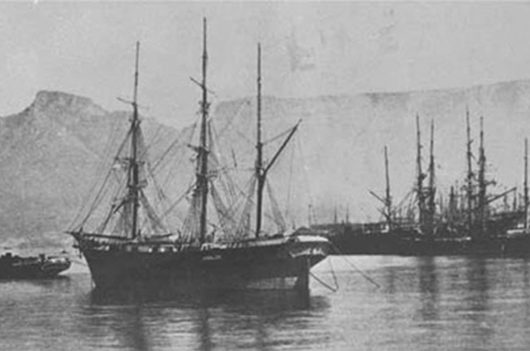The V&A Waterfront is a central part of the very beginning of the settlement of the city of Cape Town. In 1654, two years after his arrival in this relatively safe bay at the foot of Table Mountain, Jan van Riebeeck built a small jetty as part of his task to establish a refreshment station at the Cape. Fresh water and fresh produce were provided to the ships of the Dutch East India company on their arduous and lengthy journey to their outposts in Java and Batavia. The sea and the harbour lie at the heart of Cape Town’s history.
In June 1858 serious winter storms, which were a common occurrence, wrecked over 30 vessels. As a consequence, Lloyds of London refused to cover ships spending the winter in Table Bay. On a sunny day in September 17, 1860 Midshipman HRH Prince Alfred, Queen Victoria’s second son, tipped the first load of stone to start construction of the breakwater for Cape Town’s first harbour to make it a safe haven all year round for passing ships.
Harbour expansion and reclamation
The discovery of gold and diamonds in South Africa meant that the first section of harbour, the Alfred Basin, was not large enough to accommodate the increased number of ships, and the Victoria Basin was built. The construction of these two harbour basins took place between 1860 and 1920, and this area of the harbour still has an array of outstanding heritage buildings from this era.
In 1938 work was started to reclaim land between the city centre and the harbour, most notably the new Duncan Dock. The Foreshore (230 hectares) made city expansion possible. In the early 20th century South Africa depended mainly on imports for many basic articles in daily use, which explains the importance of the harbour to the people who lived here.


The V&A Waterfront today
In November 1988, Victoria and Alfred Waterfront (Pty) Ltd (“V&AW”) was established as a wholly-owned subsidiary by Transnet Ltd. Its aim was to redevelop the historic docklands around the Victoria and Alfred Basins as a mixed-use area with a focus on retail, tourism and residential development with a working harbour at its centre.
24M+
123HA
335B
21000+
Development timeline
1860–1920
1988
1990
1991–1992
1994–1995
1995–1996
1999–2000
2006–2009
2011
2012
2013
2014
2015
2016
2017
2018
2019
Installation of new swing bridge
The upgraded swing bridge replaces the previous pedestrian walkway connecting the Pierhead Precinct with the Clock Tower Precinct to cope with footfall growth that has doubled with the new developments of the Silo District, as the most direct route to the heart of the Waterfront. The new bridge reinvigorates the Clock Tower precinct with a new and iconic gateway structure, twice as wide at 4 meters, while a raised beam running down the centre of the bridge encourages people to always enter the bridge to their left.
Victoria Wharf Shopping Centre receives upgrade
The first phase of the V&A Waterfront’s spectacular R180-million extension to the Victoria Wharf Shopping centre unveiled to the public on 18 September 2019. The 10 month redevelopment of the Victoria Wharf wing adjoining The Table Bay Hotel expanded the retail area with additional shopping space by adding a third ground floor level. All three open balcony-style levels wrap around and overlook an impressive ground floor promotional court. The effect is a light and airy space enhanced by the natural light that flows in through the atrium roof.
Makers Landing
The V&A Waterfront opens the Makers Landing food hub, located alongside the Cape Town Cruise Terminal, with a vision of developing a thriving food community in which small food businesses can prosper and grow. Makers Landing represents a R63-million investment with R48-million coming from the V&A Waterfront in partnership with the National Treasury’s Jobs Fund.
2020
The Ridge
Cape Town’s newest 6-star Green Star Design awarded commercial building; the Ridge in the Portswood District is home to Deloitte Cape Town. The building has some of the most innovative sustainable building technology available, boasting a first of its kind timber façade, together with a world class interior fit out, and was the first to make use of ecobricks within its structure.

